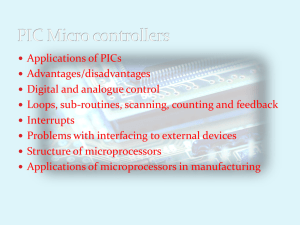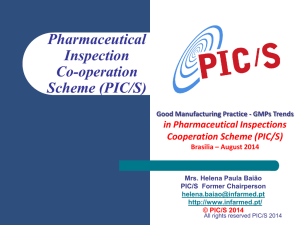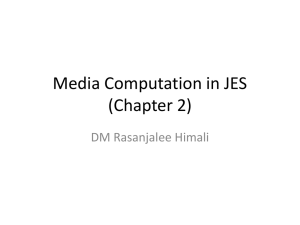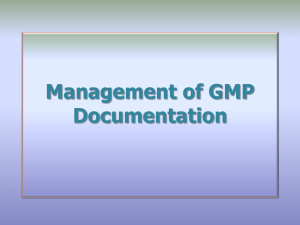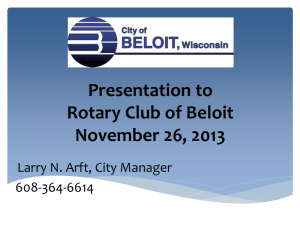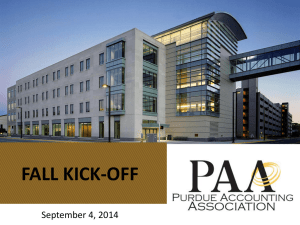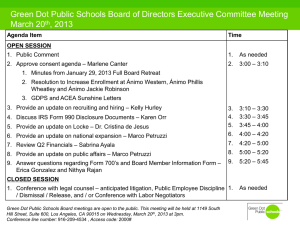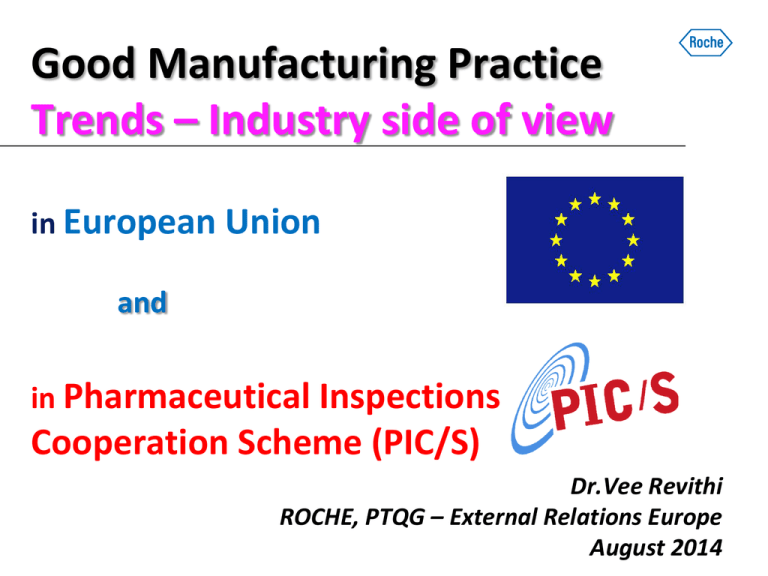
Good Manufacturing Practice
Trends – Industry side of view
in European Union
and
in Pharmaceutical Inspections
Cooperation Scheme (PIC/S)
Dr.Vee Revithi
ROCHE, PTQG – External Relations Europe
August 2014
European Union
28 Member States / 508 million people
CROATIA joined EU as the
28th M-S in 1 July 2013
Greece / ELLAS,
my country, where Princess
Europe was kidnapped by
Zeus as a bull from Phoenice
(now Lebanon) to Crete
Member states of
the European Union
Candidate and
potential candidate
countries
2
European regulatory structure in the GMPs
Principles
Directives 2003/94/EC & 91/412/EEC
EC GMP Guide Basic Requirements
Directives 2001/83 & 82
Manufacturing and Wholesale Authorisation
Detailed Guidelines
Part I
GMP Med. Products
GDPs for Med. Products
GDPs for APIs
Part II GMP Active substances
Supplementary Guidelines
Annexes 1 to 19 of EC GMP Guide
Part III : Collection of GMP
related documents, to clarify
regulatory expectations
3
Revision Procedure in EU and PIC/S
The procedure to change GMPs is continuous,
as new technologies and new data and legislation come about, or problems
come up and have to be addressed. The industry continuously sets in
questions, proposals, improvements, new ideas etc.
The fora of the technical discussion among national authorities are:
• In EU, at the EMA, Inspections Working Group (GMDP IWG)
• In PIC/S, at the PIC/S Committee of Officials (PIC/S CoO)
These two Groups cooperate closely and work in parallel on the GMP
Guidelines. There exists an agreement on the procedure used and the
changes are happening almost simultaneously.
To note that 28 of the 46 Authorities within PIC/S are EU authorities
In practical terms PIC/S and EU influence each other
and adopt the same requirements in GMPs
4
Revision Procedure in EU and PIC/S
Effort for parallel paths
(usually takes about 2 years for a document)
Concept paper
published and
commented
Initiative to
Inspectors WG at EMA
EU Commission approves and
publishes the draft
IWG agrees on new
draft
Discussion of draft with other WGs like Qualiy,
Safety, Biologics etc and approval to send to EU.
Public consultation of
draft for 3 to 6 months
Comments are assessed by IWG.
Possible discussions with other WGs
and meetings with Industry
European Commission performs final
legal assessment
Draft to PIC/S
Committee
In parallel to IWG
and EU discussions
European Commission
publishes the new Rule
Decision by PIC/S
Committee
5
Revision Procedure in EU and PIC/S
Effort for parallel paths
Timeframes:
In EU, it may take from 12 months to more than 2 years
During the EU procedure period, the PIC/S authorities are
informed and are welcome to comment as well. They are
encouraged to participate in the drafting groups
In PIC/S, the procedure starts usually after the EU and it
takes longer, as the non-EU member authorities follow each
one their own consultancy and decision making procedure.
Usually there is a time gap between the adoption by EU and
PIC/S of about 6 months to 1 year.
©2011 EDQM,
©2011Council
EDQM,ofCouncil
Europe,of All
Europe,
rights All
reserved
rights reserved
GMPs in EU
PART Ι
CHAPTER
Basic Requirements for MPs
(9 Chapters)
TITLE
DATE of issue
1
Pharmaceutical Quality System
31-1-2013
2
Personnel
16-2-2014
3
Premises and Equipment
1998 (under revision)
4
Documentation
June 2011
5
Production
(1998) (under revision)
6
Quality Control
(from 1-10-2014 on)
7
Outsourced Activities
31-1-2013
8
Complaints & Product Recall
1998 (under revision)
9
Self Inspections
1998
Blue – recently revised
Green – under revision
7
GMPs in EU
PART ΙΙ Basic Requirements for APIs (July 2010)
Identical to ICH Q7
PART ΙΙΙ
GMP related guidance documents
1. Site Master File (November 2010)
2. Q9
Quality Risk Management
3. Q10
Note for guidance on Pharmaceutical QS (31-1-2011)
(31-1-2011)
4. MRA (Mutual Recognition Agreement) Batch Certificate (31-1-2011)
5. Template for the “Written Confirmation” for APIs exported to the
EU for MPs (2-7-2013)
8
GMPs in EU
GMP Annexes (19, one blank)
ANNEX Nr TITLE
DATE
1
Manufacture of Sterile MPs
1-3-2009
2
Manufacture of Biological APIs & MPs
31-1-2013
3
Manufacture of radiopharmaceuticals
1-3-2009
4
Manufacture of Veterinary MPs other than
Immunological Veterinary MPs
1998
5
Manufacture of Immunological Veterinary MPs
31-7-2010
6
Manufacture of Medicinal Gases
31-7-2010
7
Manufacture of Herbal MPs
1-9-2009
8
Sampling of starting and packaging materials
1998
9
Manufacture of creams, liquids and ointments
Manufacture of pressurized MD Aerosol Preparations
for inhalation
1998
10
Blue – recently revised
Green – under revision
1998
9
GMPs in EU
GMP Annexes
ANNEX TITLE
DATE
11
Computerised Systems
30-6-2011
12
Use of ionizing radiation in the manufacture of MPs
1998
13
Manufacture of Investigational MPs (IMPs)
31-7-2010
14
Manufacture of MPs /Human Blood/Plasma
30-11-2011
15
Qualification & Validation
2001 (under revision)
16
Certification by a QP and Batch Release
2002 (under revision)
17
Parametric Release
2002 (under revision)
18
-
19
Reference and Retention Samples
Blue – recently revised
1-6-2006
Green – under revision
10
Comparing GMPs & GDPs in EU/EEA and PIC/S
GΜPs in ΕU
GΜPs in PIC/S
3 Parts and 19 Annexes
PART Ι Basic Requirements for MPs
PART ΙΙ Basic Requirements for APIs
PART ΙΙΙ GMP related guidance
& 19 Annexes of GMPs (18 is blank)
(PE 009-11):
PART Ι Basic Requirements for MPs
PART ΙΙ Basic Requirements for APIs
No Part III
19 Annexes of GMPs (16 and 18 blank)
& GDPs in EU
& GDPs in PIC/S
11
EMA GMDP Inspectors Working Group
EMA GMDP IWG
•
•
•
•
•
•
•
GMDP Inspectors from 28 member states of EU (43 authorities) and from
EEA countries and Switzerland meet regularly at the EMA (London), 4
times per year for 3.5 days each time. MRA partners and EU candidates
may participate as well.
They discuss and propose on the GMPs and GDPs, on technical guidance
and any other relevant document to the EU Commission.
They meet with Industry Representatives at least once a year as a group.
The meetings are supported, coordinated and chaired by the EMA.
A representative (or sometimes two) from each authority is participating.
Sub and working groups are often organized on special topics ad hoc.
Most of the EU Authorities are PIC/S members as well (only Luxembourg,
Bulgaria and Croatia are not PIC/S members).
12
PIC/S Committee
•
•
•
•
•
•
Heads of GMDP Inspectorates (or senior Inspectors) from 46 actually
Authorities/members meet regularly 2x per year, once in Geneva and once
in a host country for 1.5 days each time. Partners (EMA, WHO, UNICEF,
EDQM) and PIC/S candidates participate as well.
They discuss and propose on the GMPs and GDPs, on technical guidance
and any other relevant document.
They meet and organize training events with Professional Associations
(PDA, ISPE etc).
The meetings are supported by the PIC/S Secretariat.
A representative (or sometimes two) from each authority is participating.
Sub-committees and Expert circles are organized on special topics.
13
How EMA and PIC/S cooperate
Since 8 May 2012 EMA and PIC/S signed an agreement to
“Harmonize the Consultation Procedure “ for all GMP
documents.
The agreement provides that:
The GMP Guide and related documents should be harmonized between
PIC/S and the GMDP IWG (they need NOT be identical) to keep the
regulatory environment equivalent between the different regions.
an effective and co-operative exchange of information, including drafts
and proposals, exists between EMA Inspectors Group and PIC/S.
a list of documents subject to harmonization is established and will
regularly up-date their status
Mutual participation in drafting groups is encouraged
Effort should be there for common implementation dates.
14
Harmonization - EU & PIC/S
Actually harmonisation exists as follows:
GMPs
Chapters
EU
Chapter 1
Jan 2013
Sept 2009
On going at PIC/S
Chapter 2
Feb 2014
Mar 2009
On going at PIC/S
Chapter 3
1998
Sept 2009
OK, undergo parallel change
Chapter 4
June 2011
Jan 2013
Chapter 5
1998
Sept 2009
OK, undergo parallel change
Chapter 6
Oct 2014
Sept 2009
On going at PIC/S
Chapter 7
Jan 2013
Sept 2009
On going at PIC/S
Chapter 8
1998
Sept 2009
OK, undergo parallel change
Chapter 9
1998
Sept 2009
Status
OK
OK
15
Harmonization - EU & PIC/S
Actually harmonisation exists as follows:
GMPs
Annexes
Status
Annex 1
March 2009
Sept 2009
OK
Annex 2
Jan 2013
Mar 2014
OK
Annex 3
March 2009
Sept 2009
OK
Annex 4
1998
Sept 2009
OK
Annex 5
1998
Sept 2009
OK
Annex 6
July 2010
Jan 2013
OK
Annex 7
Sept 2009
Jan 2013
OK
Annex 8
1998
Sept 2009
OK
Annex 9
1998
Sept 2009
OK
16
Harmonization - EU & PIC/S
Actually harmonization exists as follows:
GMPs
Annexes
Status
Annex 10
1998
Sept 2009
OK
Annex 11
Jan 2010
Jan 2013
OK
Annex 12
1998
Sept 2009
OK
Annex 13
July 2010
Jan 2013
OK
Annex 14
Nov 2011
Mar 2014
OK
Annex 15
Sept 2001
Sept 2009
OK, undergo parallel change
Annex 16
Jan 2002
Annex 17
Jan 2002
Sept 2009
OK, undergo parallel change
Annex 18
_______
________
_________
Annex 19
June 2006
Sept 2009
OK
___
Not existing in PIC/S,
under revision in EU
17
Harmonization - EU & PIC/S
Actually harmonization exists as follows:
Status
GMP Guide
Part II (APIs)
July 2010
Mar 2014
OK
Site Master
File
Nov 2010
Nov 2013
OK
Inspection
Report format
May 2006
Sept 2007
OK
GDP Guide for
Finished
products
November
2013
June 2014
OK
18
Future Global Harmonisation
As PIC/S is actually under a dynamic expansion in all the
continents, with 46 Authorities / members and soon to
reach 50, it has become a very important international
forum where discussions among regulatory authorities are
held and harmonization in GMPs and GDPs is achieved
through consensus, mutual understanding and confidence.
In the present globalized environment, the goal of
Harmonization is supported by both the Authorities and
the Industry as it provides consistency and homogeneity in
the GMPs and GDPs, higher quality and efficiency and keeps
resources available.
19
Benefits of PIC/S Membership
Accession forces improvements – Discipline, SOPs.
Cost savings – more effective use of ressources.
Inspector training (Seminars, Joint, coached inspections).
Internationally harmonised GMP & GDP inspections.
Maintaining a consistently high standard of inspections.
Developping international GMPs & GDPs.
Sharing of information & experiences.
Networking & personal contacts.
20
Benefits of PIC/S Membership
Reduced duplication of inspections (cost savings).
Export facilitation (including to non-PIC/S countries).
Enhanced market access.
Reputation of industry enhanced.
Transparent inspection standards.
Consistency of inspections.
Reliable quality of medicines available locally &
internationally.
21
What is the pathway usually
GMP Inspectorates follow?
Oh, no more
resources!
Nobody can
make all on
Lets cooperate!
his own!
Join PIC/S !
Perform local
and a few FI
Strengthen local
GMPs and
perform local
inspections
Perform more
and more FI
Trust is built with
other agencies
Start sharing
information
With less resources,
better monitoring of
Manufacturers through
cooperation
22
Why Inspection Harmonization &
Coordination benefit the Industry?
Industry express often concern about the increasing number of foreign
inspections at the sites. They burden the normal manufacturing activity and
divert valuable resources to service Inspection needs. They put additional
pressure, physical and psychological to the personnel involved.
Inspectors from different authorities use often different methodology and
request various levels of detail in documentation and SOPs. Lack of
harmonization between Inspectorates is often observed and the Industry
struggles to comply with different standards.
But, it should be considered that Industry has in mind also that:
more inspections raise the probability of more observations (more inspectors
in site, more detailed monitoring).
Sometimes, inspection sharing between authorities is not really in favour of
the Industry, since it reveals observations that other inspectors might not find.
23
So, does Industry really favor Inspection
Harmonization & Coordination?
YES, despite some drawbacks in cases, the benefits are definitely
essential and important.
The
HARMONIZATION (from greek word Αρμονία: music that sounds
well) means that the GMPs & GDPs will evolve to an internationally
accepted and applied common regulation and all authorities will inspect
in the same or equivalent way.
The
COORDINATION means that Authorities will respect other
authorities’ Inspection reports and will not perform new inspection for
the same reason (for a manufacturing authorization, surveillance
inspection etc).
Ideally,
for a large site, without any big changes in production, we
could have 1 general GMP surveillance inspection every 2 to 3 years!
24
Is really a vision that can come true?
And when will that happen?
How realistic can this vision be? Which are the “tools”?
ICH is working steadily in producing commonly accepted technical guidance.
PIC/S is the main “tool” of Authorities towards harmonization.
Most authorities wants to join!
In 2014, PIC/S has 46 authorities with almost all EU, US, Canada, Australia, Argentina,
South Africa, Ukraine and some ASEAN countries among many others. Since 2002, 23
authorities have joined.
By 2017, Brazil, Turkey, Mexico & Iran will likely join to raise the number over 50.
By 2020, Russia and China will likely have applied in PIC/S. India will take longer.
Probably some African countries like Uganda and Nigeria and Arab countries like
Saudi Arabia too.
So, by 2020, Harmonization and Coordination
will be in a very good path globally
25
How can Industry & Agencies support the
Inspection Methodology Harmonization
Industry : to understand and acknowledge the reasons of expansion of
Foreign Inspections, connected to Public Health concerns.
Industry & Agencies : to realize that ALL will benefit by a proper
Foreign Inspections Coordination and ALL will save resources.
Agencies : to realize the benefits of joining global organizations and the
value of the “sharing of information” and of “sharing inspection
Reports” in protecting public health.
Agencies : to realize the importance of cooperation, of confidence
building and of using common methodology.
Industry : to support the global forums for activities like training and
communication among authorities.
26
Doing now what patients need next


